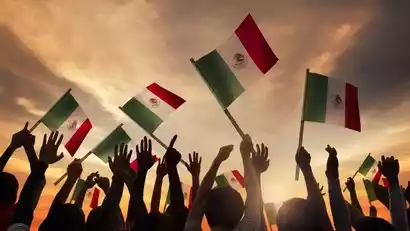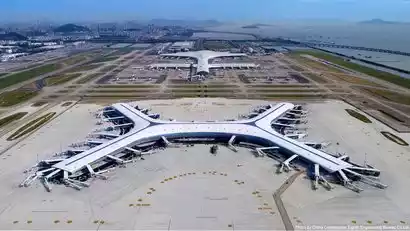Day 1: Across the country → Beijing → Mexico City
All day
Today, we arrived at the Capital International Airport at least three hours in advance and took a Hainan Airlines flight to Mexico City, the capital of Mexico.
Regarding interline flights:
Shanghai, Hangzhou, Dalian, Xi'an, Chengdu, Xiamen, Chongqing, Fuzhou, Shenzhen, Guangzhou, Changsha, Wenzhou, and Wuhan can arrange Hainan Airlines intermodal flights to and from Beijing free of charge. Flights can be submitted according to personal needs, but the specific flight information is subject to the approval of the airline.
Regarding visa issues:
According to Mexican customs regulations, visitors with US, UK, Schengen, or Canadian visas (multiple-entry visas valid for at least six months and with at least one visit to the country where the visa was issued) can enter Mexico visa-free. If you hold a visa for one of these three countries but haven't visited the country where the visa was issued, you may be denied entry and boarding. Please be aware of this before applying!
Arrive in Mexico City in the evening and check into the hotel to rest.


Day 2 Mexico City Day Trip
·morning
Since we arrived late, we gave the tourists some time to rest. After a free lunch, we started our tour of the western part of Mexico City.
·afternoon
Visit the Mexico City Museum of Anthropology: the largest museum in Latin America, this museum stands out in the world for its outstanding combination of traditional Indian style and modern art architecture, as well as its unique and fascinating collections, showcasing the Mexican Indian civilization, Aztec civilization, and Mayan civilization.
Visit Chapultepec Castle: This is the only remaining royal castle in the Americas and currently houses the National History Museum. Its lavish interior houses numerous items used by European royalty, including exquisite murals, gold and silverware, sculptures, and other artworks. This offers a glimpse into the life of the nobility during the Spanish colonial era in Mexico.
·night
Dinner arrangement [Mexican style meal]: A dream dance on the tip of your tongue presented by the emerging food empire. While enjoying the cheerful Mexican dance and music performances, you can also taste the local specialties.
Then return to the hotel to rest.


Day 3 Mexico City → Teotihuacan → San Miguel
·morning
After breakfast at the hotel, we will drive to Teotihuacan, a suburb of Mexico City, to explore the ancient ruins.
Teotihuacan, meaning "the place where the sun and moon gods were created" in the Nahua language, is an ancient city site in Mexico. The city reached its peak between the 1st and 7th centuries AD and is one of Mexico's most important archaeological sites.
Among them, the most famous are the Pyramid of the Sun and the Pyramid of the Moon. Together, they are also called the Sun and Moon Pyramids, representing people's worship of the sun god and the moon god respectively at that time.
The Aztecs believed that all the gods offered themselves here as sacrifices, allowing the sun to illuminate the world at the dawn of the fifth century. The Sun and Moon Pyramids and the Quetzalcoatl Temple tell the story of how the gods created the heavens, the earth, and humanity, and also embody the inhabitants' respect and expectations for the gods.
·afternoon
Afterwards, we will drive to San Miguel, located in central Mexico, the northernmost Spanish colonial city. This is a famous art city in Mexico, where many down-and-out artists once gathered.
After arriving, check in at the San Miguel Parish Church. This pink "wedding cake"-style church with high towers is very unique and eye-catching.
·night
At sunset, we headed to El Mirador, the town's official observation deck. It offers a wide view and is a great spot for scenic views.
After dinner, check in to the hotel and rest.


Day 4 San Miguel → Guanajuato
·morning
After breakfast at the hotel, continue your tour of San Miguel's old town. With over 500 years of history, the town's Spanish colonial era remains deeply etched in every corner, while vibrant colors and diverse decorations subtly showcase its Indian charm.
Tourists strolling through the streets will likely pass by must-see churches and squares. Furthermore, art shops, galleries, cafes, and bars are scattered throughout the town, so it's best to venture into any that catch your eye.
·afternoon
After lunch, we'll head to Guanajuato, the colorful town that served as the inspiration for the film "Coco." A UNESCO World Heritage site, Guanajuato boasts diverse architectural styles. Tree-filled plazas and brightly painted houses tucked into the steep slopes of the canyon.
Visit Union Square, San Diego Cathedral and the Gran Teatro Juárez, which is known as the most luxurious theater in Mexico.
·night
In the evening, we will take a cable car ride to enjoy the sunset at Mount Pipila, overlooking the entire Guanajuato city. This is also a world-famous sunset viewing spot.
After dinner, check in to the hotel and rest.


Day 5 Guanajuato → Querétaro → Mexico City
·morning
After breakfast at the hotel, we will go to the famous Kissing Alley, which is known as the narrowest alley in the city. People believe that couples who kiss here will never break up.
Check out the Hidalgo Market, La Paz Square, the Art School of the University of Guanajuato, and the magnificent and beautiful La Compañia Cathedral in Guanajuato.
·afternoon
Drive to the Mexican Heritage City of Querétaro.
The historic center of Querétaro: The colonial architecture here is well-preserved, and strolling the cobblestone streets feels like stepping back into the 18th century. Visit the Cathedral of Querétaro, whose bell tower is a landmark of the city!
Querétaro Aqueduct: This 23-meter-high aqueduct was built in the 18th century to solve the city's water supply problem.
Querétaro Gardens: There are a variety of plants and flowers here. Walking among them, it feels like being in a colorful fairy tale world.
[Calendar Museum]: Here tourists can see the Aztecs' achievements in astronomy and further appreciate the rich historical and cultural resources of this small town.
·night
Afterwards, return to Mexico City and check in to your hotel.


Day 6 Mexico City → Havana (Actual flight is subject to the tour notification)
All day
Today, we will go to the airport in time according to the flight schedule and take the flight to Havana.
After being picked up by the tour guide, check in to the hotel and rest.


Day 7 Havana → Varadero
·morning
After breakfast, depart for Varadero, the Cuban Mediterranean resort.
Pass by Lookout Hill, Hemingway's former residence: Follow the life of the great writer Hemingway. This place has become a famous museum, and the Nobel Prize winner in literature attracts many visitors. Hemingway's immortal masterpiece "The Old Man and the Sea" was written here.
·afternoon
Drive to Varadero. Here, you'll find a 22-kilometer white sand beach, one of the world's top ten. The scenery is breathtaking, with clear blue waters, schools of fish and shrimp, and vibrant corals. The beach stretches gently, broadly, and boasts tall palm trees.
Tourists can spend the afternoon freely and enjoy their vacation.


Day 8 Varadero → Havana
·morning
This morning, tourists can continue to enjoy their leisure time by the Caribbean Sea, and are free to participate in activities or relax in the hotel. Varadero Hotel is an all-inclusive hotel.
·afternoon
After a free lunch, we will return to the capital Havana by bus, which takes about 3 hours.
·night
In the evening, we will go to Morro Castle on the beach in Havana. We will climb up Morro Castle to watch the cannon salute ceremony.
Guards in gorgeous uniforms will march into the heights of the castle, and after a brief and solemn ceremony, they will fire ancient salutes and close the heavy city gates. This has become a "nightlife" that every tourist visiting Havana cannot miss.
After dinner, check in to the hotel and rest.
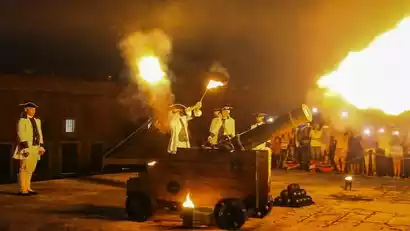
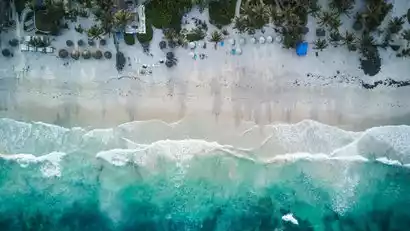
Day 9 Havana Day Trip
·morning
After breakfast, start the tour of the old town and the new town:
First, let’s take a look at the Havana Capitol, which is the most iconic building in Havana. The entire building is made of marble, with exquisite and prosperous walls and decorated with a variety of classical lamps.
The exterior of the Grand Teatro de Havana, one of the largest opera houses in the world. The four corners are decorated with angel statues representing education, music, fraternity, and drama. Besides being a stage for music, opera, and film performances, the building also serves as a stage for music, opera, and film performances.
Afterwards, we'll embark on a tour of Old Havana, a UNESCO World Heritage Site in 1982. This treasure trove of architectural art, steeped in centuries of history, is filled with cultural and historical charm.
Plaza de España blends Baroque and Art Nouveau styles, and its colorful arcade arches are another of its characteristics. During the colonial period, the square served as a vendor's market, bullring, and slave trading ground, but has now been replaced by artistic cafes and museums. The Two Worlds Hotel (exterior), standing near the Plaza de Armas, was where Hemingway first stayed in Cuba. Room 511, where he stayed, has been converted into a small museum, with its items and furnishings preserved in their original state, offering views of the old town and the harbor.
Visit the Rum Museum. Besides cigars, rum is an essential part of this country, known as the "Isle of Rum." Housed in an 18th-century colonial courtyard, the museum showcases the entire process of making Cuban rum, from sugarcane to rum, through models and artifacts. After the tour, visitors can enjoy a tasting of the renowned Cuban rum.
The Plaza de la Catedral is surrounded by Baroque aristocratic mansions, the most eye-catching of which is the Havana Cathedral, Cuba's oldest church. Its solemn and austere interior is filled with artwork and sculptures, and the altar is decorated with gold, silver, and agate.
·afternoon
For lunch, head to the Five Cents Tavern. Hemingway was a beloved tavern during his lifetime, and many poets and writers were its guests. The bar's unexpected fame stems from the painting "My Moito in La Bodeguita," written by Hemingway, displayed on the bar counter. It was here that Hemingway completed his immortal masterpiece, "The Old Man and the Sea."
Special arrangement* Enjoy lunch at the bistro, listen to passionate Cuban music, and savor a famous mojito cocktail. Feel the leisurely atmosphere of Hemingway in just one glass of wine!
After dinner, we started to roam around Havana New Town:
Havana's Plaza de la Revolucion is a key landmark for Cuba's political and military leadership, and is also the venue for major national celebrations and large-scale parades. Located on the north side of the square is the José Martí Monument, a national hero. This monument commemorates the centennial of the birth of José Martí, the Cuban patriotic poet who championed the overthrow of Spanish colonial rule. Opposite the monument is a portrait of Che Guevara, accompanied by a sign reading "Always Marching Toward Victory," pointing to the Ministry of the Interior building.
[Havana Classic Car Tour] (approximately 1 hour) Speed along the Malecón, the filming location of "The Fate of the Furious," and experience the scenery from the movie. On one side, the sea exudes a romantic and alluring atmosphere. On the other, ancient buildings evoke a sense of timelessness. During the day, young people hang out here for romantic conversations, fishing, and swimming. At night, they relax and enjoy a beer, sing songs, and dance to the music on the embankment. Finally, stop at the Morro Castle, built in 1632, for a panoramic view of Havana's city center and harbor, a scene of diverse charm and beautiful scenery.
·night
After dinner, check in to the hotel and rest.
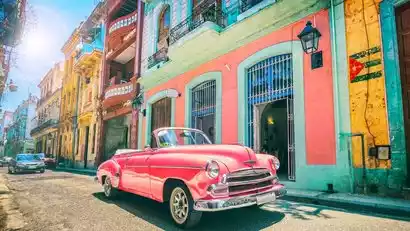
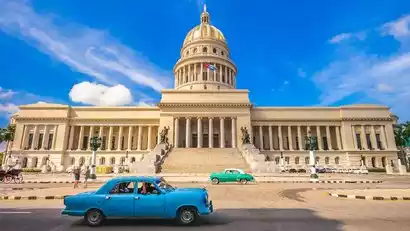
Day 10 Havana → Valle de la Yunis → Havana
·morning
After breakfast, we will head to Yunnis Valley, known as the "Little Guilin", which was listed as a World Cultural Heritage in 1999.
Along the way to the Yunes Valley, tourists will admire the sweeping peaks and dramatic rock formations of the Guaniguani Mountains, and the vast pine forests that line the banks of the Pinar del Río River. As you travel along the central road toward Pinar del Río, you'll first encounter the lush, steep peaks of Monte Vigo, once a UNESCO Biosphere Reserve. The reserve is filled with winding trails that offer unique and beautiful flora and fauna, as well as the remains of French coffee plantations. There are also cascading waterfalls and turbulent rivers.
Visit a cigar farm. A guided tour of the plantation and tobacco drying huts will provide insights into tobacco growth, manual harvesting, fermentation, and inspection. Observe the cigar-making process up close as experienced rollers skillfully roll cigars, emblems of capitalism. The complex and complex production process ensures superior quality, making cigars synonymous with Cuba and internationally renowned.
·afternoon
At noon, enjoy organic cuisine at the private farm restaurant.
Special arrangement for cigar tasting: a dedicated person will teach the process of smoking cigars, and give each guest a cigar and a glass of special wine to experience the charm of Cuban quintessence.
In the afternoon, explore the Indian Caves. These karst caves, featuring stalactites and undercurrents, were originally a refuge for Native Americans seeking refuge from Spanish colonists.
Special arrangement* Take a boat cruise along the winding underground river to explore the remains of the Indians' past and admire the stalactites and bizarre stalagmites on both sides, starting your adventure voyage.
Admire the Jurassic Prehistoric Murals. Commissioned by Castro, these large-scale murals depict prehistoric creatures. The murals took four years to create, using natural minerals to depict the evolution of reptiles, dinosaurs, and apes. The bold colors contrast spectacularly with the lush greenery of the mountains.
·night
Dinner is specially arranged at the [SAN CRISTOBAL PALADAR restaurant, where former US President Obama has visited, to enjoy a local special meal].
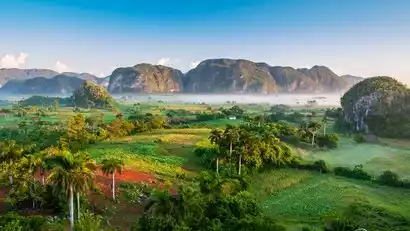
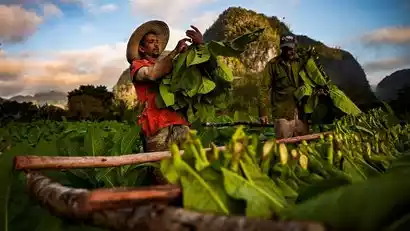
Day 11 Havana → Cancun (Actual flight is subject to the tour notification)
All day
Take a flight from Havana to Cancun and have free time upon arrival. Tourists can go to the beach to relax and swim, or do whatever they like.
Cancun is located in the northern Caribbean Sea, on the northeastern tip of Mexico's Yucatán Peninsula. The island is serpentine in shape, connected to the Yucatán Peninsula by bridges at its northwest and southwest ends. It faces Cuba across the Yucatán Channel. Surrounded by the sea on three sides, the city offers breathtaking scenery.
Enjoy a relaxing vacation in Cancun.
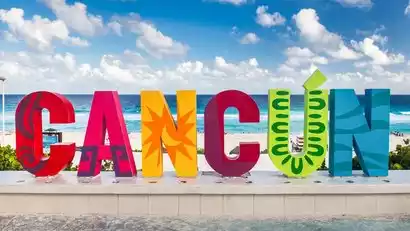
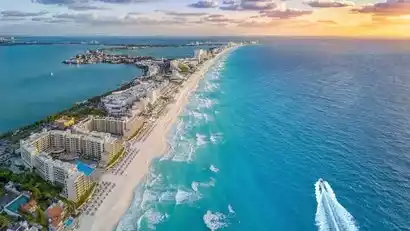
Day 12 Cancun → Chichen Itza → Cancun
All day
After breakfast, visit the renowned Mayan site of the Quetzalcoatl Pyramid of Chichen Itza. Incorporating architectural styles from different periods of the Mayan and Toltec eras, the pyramid's design was meticulously calculated, embodying the Mayan calendar. The four sides, each with 91 steps, and the rectangular top, total 365 steps, the exact number of days in a solar year. Even more astonishing is that on the annual equinoxes (March 21st) and September 21st, sunlight striking the pyramid creates a serpent-like pattern, descending the steps to meet at the base. The Mayans considered this unique phenomenon the arrival of the Quetzalcoatl.
Afterwards, we'll visit the elliptical Observatory, the largest ball court in Mayan ruins, and the Mayan astronomical observatory. The Mayans not only demonstrated their exceptional architectural skills, but also used it to observe the sun, moon, and even Venus. Nestled in the dense, ancient jungle, its appearance is remarkably similar to a modern observatory. Several observation windows remain in the half-collapsed dome, which the Mayans used to observe the movement of Venus.
Afterwards, we headed to the altar statues of the Temple of the Warriors, which are even more magnificent than their original prototypes due to Mayan architectural techniques. The Temple of the Warriors is a stone structure with a stepped pyramid-shaped roof. The internal pillars are carved into the shape of warriors. At the top of the pyramid steps leading to the temple entrance is an altar statue of the Chac Mool angel.
·afternoon
Then we took a bus to the Suytun cenote, which was the third filming location of "Coco" we visited on this route. At noon, a beam of Jesus light would pass through the cave and hit the roof of the Mayan sacrifice. Here you can take beautiful photos with Mayan intentions.
·night
Afterwards, we will return to the beautiful coastal resort city of Cancun. If you have enough time, you can enjoy free time.
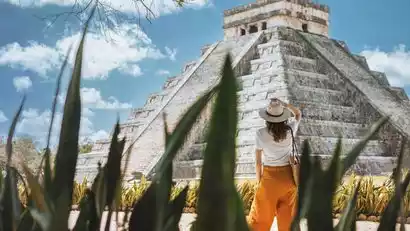
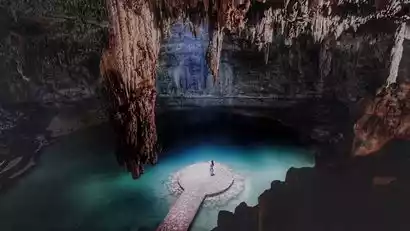
Day 13 Cancun → Mexico City (Actual flight is subject to the tour notification)
·morning
After breakfast, we will fly back to Mexico City. After lunch, we will start our half-day city tour.
·afternoon
The tour begins at Plaza de la Constitución, one of the largest squares in the world. To the east is the National Palace, to the north is the Cathedral of Mexico City, and to the south are the City Hall offices.
The National Palace is the seat of Mexico's executive branch and the nominal office of the president. Only a limited area is open to the public. Among the tourist attractions is the mural by renowned artist Diego Rivera, a national treasure of Mexico.
Special attention* Please decide whether to enter the venue based on the actual situation.
The Templo Mayor ruins were considered the center of the world by the Aztecs. Upon entering the ruins, you can follow the original archaeological excavation route, exploring the site floor by floor. Adjacent to the ruins is the four-story Templo Mayor Museum, included in your admission price. It's a great place to learn about Mexican Inca culture.
Cathedral: This is the largest Catholic church in Latin America, integrating different architectural styles such as Renaissance, Baroque and Neoclassicism.
Next, we'll visit the Central Post Office. The 2017 tear-jerking animated film "Coco" takes place in Mexico, and many of the film's scenes are based on real-life locations. The service hall where the protagonist first enters the world of the dead is modeled after the Postal Palace itself. Here, we'll give tourists a postcard to send to someone they miss, creating a special commemorative experience.
·night
After dinner, proceed to the airport.
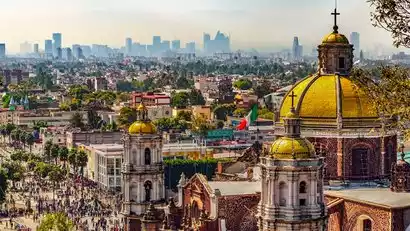
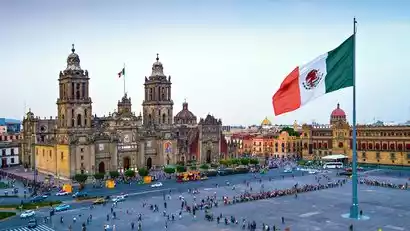
Day 14 Mexico City → Beijing (1.5 hours via Tijuana)
All day
After arriving at the airport in the early morning, I took a flight via Tijuana and then flew to Beijing.
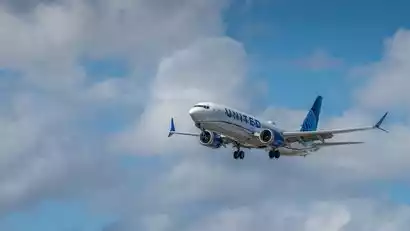

Day 15 Beijing
All day
The trip ends after arriving in Beijing.
